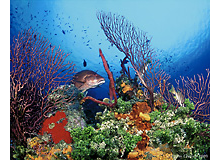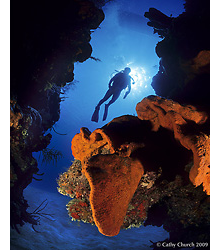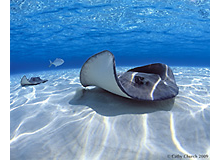Weights: The right equipment for divers and the right equipment for photographers may not be perfectly the same. Photographers have to hold their bodies at all types of odd angles while they are holding a camera that can weigh up to a few pounds underwater. This means that you must keep your center of balance as close to your center point as possible. With heavy cameras, your main weight system must be at your back, and definitely not in pockets in the front of your B.C.D. The closer they are to your body, the less changes you feel as you twist for that perfect camera angle. The further away they are, such as out at the tank, high on the back pack, or at the sides on your BC, the more torque they can deliver and the more their effect changes as you turn. This makes you less stable.
The heavier the camera system, the more important this becomes. With the heaviest systems (such as some housed SLRs or mirrorless cameras with the large 180º viewfinder and an extreme close-up lens) you will be more comfortable with ankle weights. Don’t forget to take off the lead from your belt that you are adding to your ankles.
BCs: If your BC uses integrated weights, keep in mind that they make it difficult for many types of underwater photography so use a belt if you have one. BCs with integrated weights are difficult for photographers because they do not allow you to adjust the position of the weights to the back of your waist. Pockets high on the back aggravate your forward tilt when you need to lean just partly forward. I sometimes adjust my weights during the dive so that I can lie on my side, or remain straight, depending on the angle I need to hold my camera for the photo.
BCs with the air just on the back also aggravate movement. For example, suppose you are holding level and the air in the BC is in the middle, at the top (of course) and then you need to roll just a little to the side for the best camera position. Suddenly all of the air moves to the left wing of the BC. Because it is several inches from your body, it has more leverage than air that is held close to the body in a full jacket or wrap around BC. This extra leverage is translated into instability while you are trying to hold a camera within an eighth of an inch of that Christmas tree worm.
Every time I take a student who is struggling in the water with an “Angel Wing” BC, and lend them one of my SeaQuest Spectrum BCs, they improve dramatically and quickly. None of them really knew that they were having a problem until I watched them in the water. All of them felt the difference and switched BCs.
Mask: If you have trouble seeing your camera settings or tiny creatures, get prescription lenses! Contact Cathy if you need advice for photographers needs and contact www.prescriptiondivemasks.com for info. For modeling, use an open oval window, or any face plate that continues across the bridge of the nose. Separate plates or tear-drop lens shapes often make the model look sad.
Fins: Booties make your feet float, so, in warm tropical water, smaller, full-foot fins are easier to balance when holding a camera. If you are getting ready to buy fins, please AVOID the split fin and Force Fins™. These are not good for small maneuvers which you must constantly make for good Underwater photo control. If you still have your old fins, especially if they are a simple blade fin, and not particularly long, bring them instead.
Aiming lights: Small Underwater flashlights can be strapped or held to your strobe with expensive flashlight holders or cheap, large rubber bands, but large flashlights cannot be used efficiently for night photography; they scare the critters away, annoy other divers and make the camera system too cumbersome. The new LED flashlights are great at night, but the ones I have seen are not powerful enough for daytime use further than a foot away. I use the Ikelite PCm and PCa flashlights that use four and six AA batteries respectively and I love them.
The hottest new lights are the Sola LED lights. (And I should not say they are the hottest, because they work much cooler and therefore need a smaller battery package for the amount of light they produce.) While they are much more expensive, they offer an adjustable soft wide beam or a narrow spotting light. You can turn on a red filter to reduce scaring your night creatures.
For auto-focus cameras, when you do not have a built-in focus light in your strobes, you should carry one all the time for focusing in dim areas and to check on color. You can attach it with an ultralight system to the mounting shoe on the top of some housings.
Keep warm: Since you will often be waiting without moving for a creature to stick his face into your photo area, you may want a thin dive skin such as a PolarTech™ or a Darlexx™, 1/8″ or 3/16″ wetsuit even in warm 85-degree water, if you chill easily. In the coldest water, wear a dry suit. You often need more than divers who are swimming constantly, but you also want to use as little as you are comfortable with so that your need for weights is less, and you will have less buoyancy changes with depth. In cool water a hood or hooded vest provides the most efficient source of warmth with the least effect on buoyancy.




